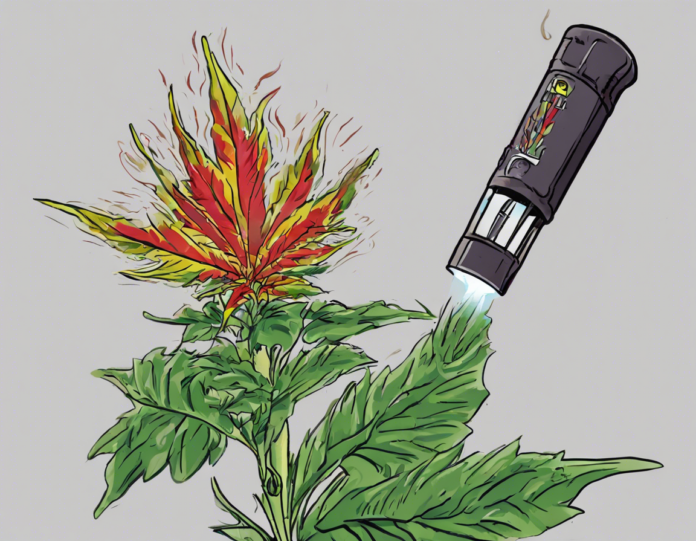Introduction
Torch Weed, also known as Verbascum thapsus or common mullein, is a common invasive plant found in many areas around the world. This tall, biennial plant with distinctive yellow flowers can quickly take over fields, pastures, roadsides, and other open spaces if left unchecked. Its ability to spread rapidly and outcompete native plants makes torch weed a serious threat to biodiversity and ecosystem health.
Identification
Before discussing control and removal methods, it’s essential to be able to correctly identify torch weed. Torch weed has several distinguishing features:
- Size: Torch weed typically grows between 3 to 7 feet tall, with some specimens reaching up to 10 feet in height.
- Leaves: The plant has large, soft, fuzzy leaves that form a basal rosette in the first year and a tall flowering stalk in the second year.
- Flowers: Torch weed produces dense spikes of bright yellow flowers that can attract pollinators.
- Seeds: Each plant can produce thousands of small seeds that remain viable in the soil for many years, leading to persistent infestations.
Why Torch Weed is a Problem
Torch weed can have significant negative impacts on the environment, agriculture, and human health. Some of the reasons why torch weed is considered a problematic invasive plant include:
- Competitive Advantage: Torch weed has a rapid growth rate and the ability to outcompete native plant species for resources like sunlight, water, and nutrients.
- Habitat Degradation: The dense growth of torch weed can crowd out native vegetation, reducing biodiversity and altering ecosystems.
- Fire Hazard: Dry torch weed plants can pose a fire hazard in arid regions due to their flammable nature.
- Livestock Concerns: Torch weed is unpalatable to most grazing animals, reducing forage availability in infested areas.
- Allergies: The fuzzy leaves of torch weed can trigger allergies in some individuals when touched or inhaled.
Control Methods
Effective control of torch weed requires a multi-faceted approach that integrates various strategies. Here are some methods commonly used to manage and eradicate torch weed infestations:
- Mechanical Control:
- Hand Pulling: For small infestations, hand-pulling torch weed can be effective, especially when the plants are young and have not yet set seed.
- Mowing: Regular mowing can prevent torch weed from flowering and setting seed, reducing its spread. However, mowing alone may not eradicate established plants.
- Chemical Control:
- Herbicides: Selective herbicides can be used to target torch weed while minimizing harm to desirable vegetation. Glyphosate-based herbicides are commonly used for torch weed control.
- Biological Control:
- Insects: There are several insect species, such as mullein moth (Cucullia verbasci), that feed on torch weed and can help reduce populations. Introducing these biocontrol agents should be done cautiously to prevent unintended consequences.
- Preventive Measures:
- Soil Disturbance: Preventing soil disturbance in areas prone to torch weed infestations can help reduce seed germination and establishment.
- Monitoring: Regular monitoring of infested areas is crucial to detect and treat torch weed early before it spreads further.
Removal Techniques
While controlling torch weed is essential, completely removing it from an area may require additional steps to restore the ecosystem. Here are some techniques for removing torch weed:
- Root Digging: Since torch weed has a deep taproot, removing the entire root system is crucial to prevent regrowth.
- Mulching: Applying a thick layer of organic mulch can smother torch weed plants and prevent them from regenerating.
- Solarization: Covering the infested area with plastic sheets to harness solar heat can effectively kill torch weed and its seeds in the soil.
- Revegetation: Replanting native vegetation after torch weed removal can help restore the ecological balance of the area and prevent reinfestation.
FAQs (Frequently Asked Questions)
Q1: Is torch weed poisonous to humans or animals?
A1: Torch weed is not considered highly toxic, but the fuzzy leaves can cause skin irritation in some individuals. It is also unpalatable to most animals, which helps it spread by reducing grazing pressure.
Q2: How fast does torch weed spread?
A2: Torch weed is known for its rapid spread, both through seed dispersal and vegetative growth. A single plant can produce thousands of seeds that remain viable in the soil for several years.
Q3: Can torch weed be composted?
A3: Composting torch weed is generally not recommended unless the compost reaches high temperatures that can kill the seeds. Otherwise, the seeds may survive the composting process and germinate in new locations.
Q4: Can I use torch weed for any beneficial purposes?
A4: While torch weed is considered invasive in many regions, some herbalists use its leaves and flowers for medicinal purposes. However, collecting torch weed for personal use should be done responsibly to prevent further spread.
Q5: How long does it take to eradicate torch weed from an area?
A5: Eradicating torch weed can be a long-term process that may take several years, depending on the extent of the infestation and the chosen control methods. Regular monitoring and persistence are key to successful removal.
In conclusion, managing and removing torch weed requires a combination of approaches tailored to the specific infestation and location. By understanding the characteristics of torch weed, utilizing effective control methods, and implementing removal techniques, landowners and conservationists can work towards containing and eliminating this invasive plant to protect native ecosystems and biodiversity.





